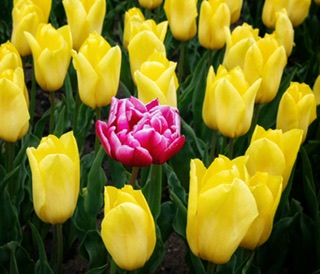It’s been that time of year when bluebells and then tulips are in bloom.
Following the herd
Unsurprisingly, these flowers and many others are a draw for photographers due to what the genre offers: vibrant colours, petals and just the generally pleasant image for the viewing eyes.
Such images spring up (pun intended) on social media just as sure as night follows day.
It can feel like following the herd, jumping on the bandwagon, joining the masses. However, with such treats for the eyes, why not take your camera anyway just in case an opportunity presents itself?
Lending itself to the strategy described above is the fact that my wife, like many women, loves flowers. So when the season of snowdrops, bluebells or tulips present themselves, she’s always keen to take a look.
Author Edit: Of course, many men like flowers too, and I don’t think there’s a law against it.
Challenges of flower photography
I find photographing flowers quite a challenge.
General challenges include:
- Depth of field – flower petals have differing depths therefore suit a narrow aperture which in turn can be challenging if the light is poor
- Focus – due to the same challenge above, many photographers who specialise in flora images use a macro lens – they may often use a tripod and focus stack
- Composition – a straight on or top down shot of a flower can be bland, a snap or nothing different from any other shot, but low down compositions provide better impact but can require a physical contorted position suited to a fit acrobat
- Weather conditions – windy conditions or even a breeze which moves the flowers can make capturing images especially difficult
Having made it sound impossible, I have a few half decent ones in my back catalogue.

Bluebells
We have three places on the bluebells trail.
One is at a church with a small wood then a larger wood with a decent walk between them. This one is appealing despite an entrance fee because there’s an opportunity for homemade cake and a nice cup of tea.
The second location is a drive and not well known but one a previous visit before has yielded a couple of nice shots.
The third and most popular is the Blickling estate which we visited this year a week or two before the peak of Bluebell season.
Blickling 2024
I took my 24-120mm lens with me to see what I could get by thinking a little more carefully about my composition.
To our surprise, the bluebells looked pretty good and we had a bit of afternoon sun shining through the trees.
The shot below is probably my best close up shot of the afternoon.
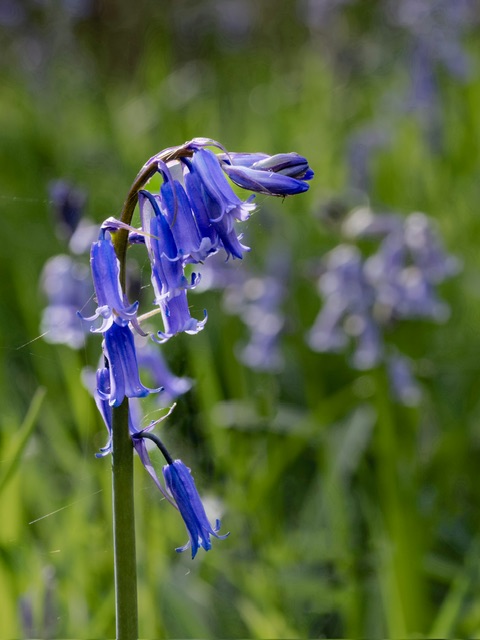
It was very difficult to capture these isolated flower shots because it usually requires bending down position which for the more mature amongst us with dodgy knees can incite pain.
It can also be difficult to find one without a cluttered background, and as described earlier, if you’re inclined to use a narrow aperture, you are not going to blur the background so will have to consider that in post-production editing.
We continued to wander round and I wanted a blanket of tulips with some dappled light – not too much to ask is it?
The best I could muster is below, and I’ve made the most of the light in the edit by playing around with the exposure, shadows and highlights, white and black sliders in Lightroom.

I did a similar shot just after the one above but zoomed in to get more of the ground, and in my mind, I had the tip of odd numbers work well.
My eyes saw a dominant group of three trees in a subtle diagonal so that’s why pressed the shutter on this scene.

Tulips
On my first visit three years ago, I wrote about Kathryn’s fantastic tulip shot with her phone.

Kathryn booked tickets for the annual Tapping House charity tulip event at Hillingdon West Norfolk.
The western region of Norfolk is well known for tulips and every year the Tapping House hospice charity commandeers fields of tulips with agreement from a local farmer and sells tickets.
The tickets are £7.50 each for a 40 minute time slot but on our two visits to date we’ve never seen anyone moving people along. You park up in the designated area, then wander between the rows of tulips in the fields.
As well as all the challenges of photographing flowers as described earlier, it can be difficult to get a shot of the field without people in the scene.
At first, I wasn’t overly bothered about going again but I did enjoy the challenge, and rather than immediately rule it out in future, I think I would go again. But there is potential for not bothering… read on…
Expectations when visiting
It’s well worth a visit and raises money for a good cause so I would recommend it, but you now have to be quick on the keyboard as they now sell 10,000 more tickets than they used to (25,000 tickets in total) and they sell out in an hour or two.
What that means is many more people, and I mean a lot. You have to be prepared for other people to occasionally or often be in your way.
With so many more people visiting at a time, the ultra wide shot below of a field from three years ago will be harder to capture without cloning lots of people out.
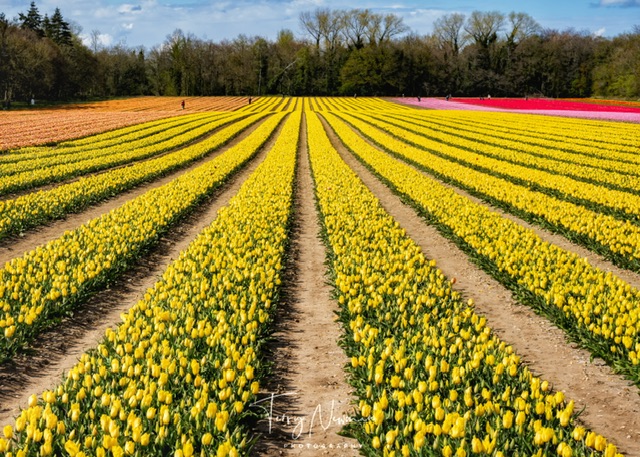
There also seems to be a lot of TikTok and Insta folks posing with props and parading around, and some sights catching one’s eye can be difficult not to emit a sigh under your breath.
There are kids who’ve been dressed up and must be cold in their dresses or other inadequate for the weather clothing. Their parents have their winter jackets on of course, presumably as they’re so fixated on a cute shot, they’ve not considered that their kid might be freezing cold!
Quite clearly, the generation gaps can be felt here.
I think what I’m really saying here is that the location and event can be additionally challenging for grumpy old bastards like me.
2024 Captures
This year, I took my 24-120mm lens as I had taken to Blickling but I also took my fisheye lens as a bit of an experiment.
In the end, it was a bit of a pain switching lens in the tight space of the row between lines of tulips and some of my close up shots make me wonder if I go again in future, I may have a telephoto to see if that gives me a different perspective.
The fisheye was interesting and captured some half circle images but the issue was as stated above. They all had sky and people in them. However, I like the shot below which you can just about see the effect of the fisheye lens.
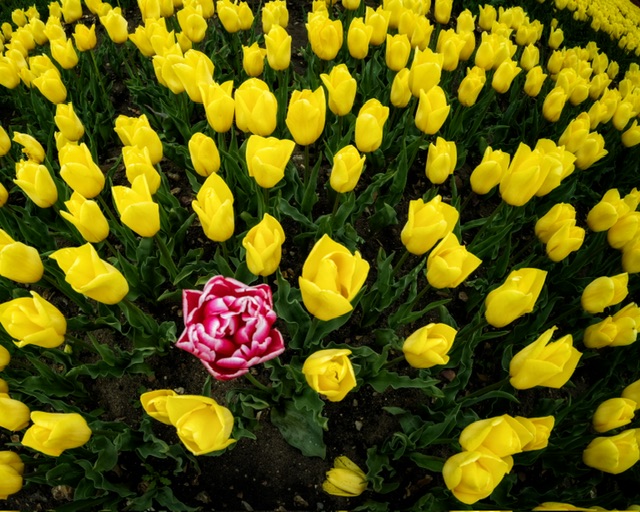
Trying to remind myself to think about composition more, I tried shooting this particular stand out scene lower down.
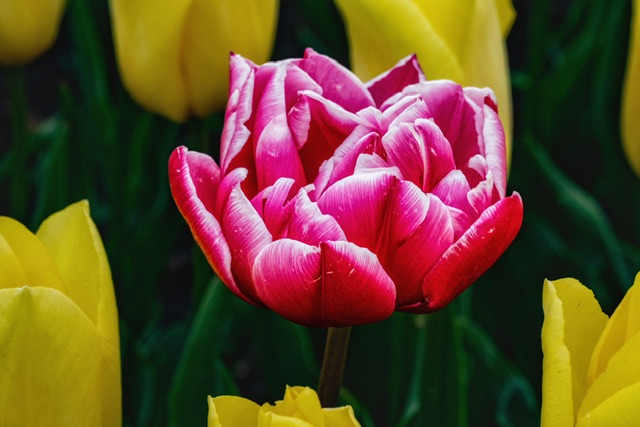
The fisheye was fun but I was achieving more with the 24-120mm giving me wide and a bit of reach too.
With 45 megapixels to play with on my Z7, I also deployed crop mode when I needed it to get in to 180mm and the drop to 24MP would be fine as I knew I wouldn’t be cropping much.
Below are a couple of montages of shots.
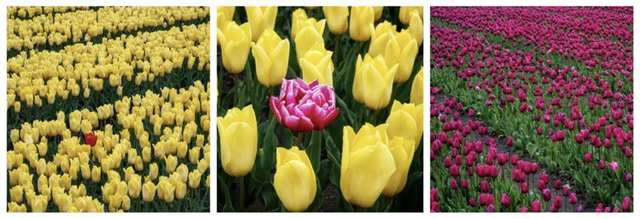
I tried to get very low down shots which definitely have more impact but they are tricky unless as I wrote earlier you are something of a gymnast!

I went about trying to get more of the lower down shots and like them a lot.

While it’s right to get those close up and low down shots, it’s hard to resist a ‘field’ shot.
I was consciously trying to ensure a diagonal view when capturing fields, and I generally tried to capture two colours.

No doubt a competition judge would be checking shots against a colour wheel, but for me shooting casually, I’m going with what I saw in front of me.
My last two images to show are close up shots.
This striking red tulip caught my eye and I left the speckles on it rather than remove them all in post.
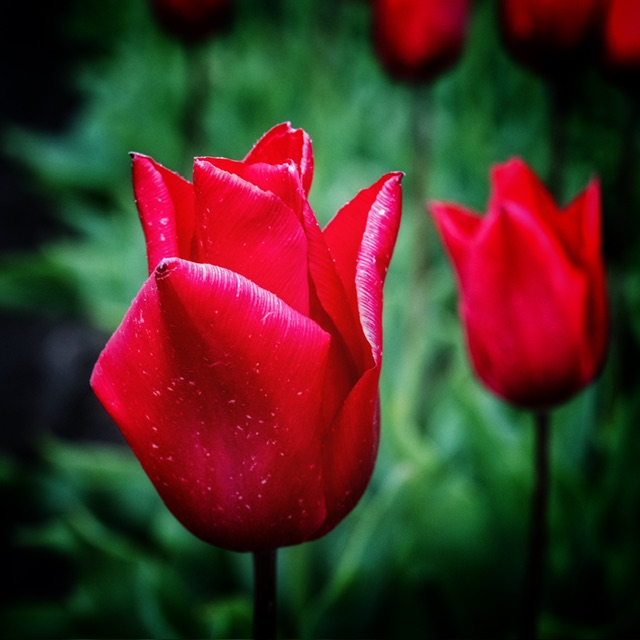
You’ll spot I added a dark vignette as well to reduce the visibility of any peripheral clutter and draw the eye into the tulip.
Lastly, the shot below shot from above.

An extreme vignette to isolate the multi-coloured tulip.
Final thoughts
Flower photography is not the easiest but it is very satisfying and rewarding.
My learning is to experiment, try different lenses, focal lengths and shoot different angles. Look and observe my surroundings more carefully without haste.
I saw a lovely image on social media of a row of tulips and their reflections in a puddle which I thought was nice and something different.
I’ve captured all my flower images without a macro lens, and the macro lens I did briefly own got traded in a year after purchase unused.
In future, I shall choose a specific lens and stick to it and I can see a ring light or something similar could help maintain a narrow aperture, avoid the ISO being cranked up very high and eliminate the desire for a tripod which many locations do not permit.
Until the next time.
Onwards and upwards…
